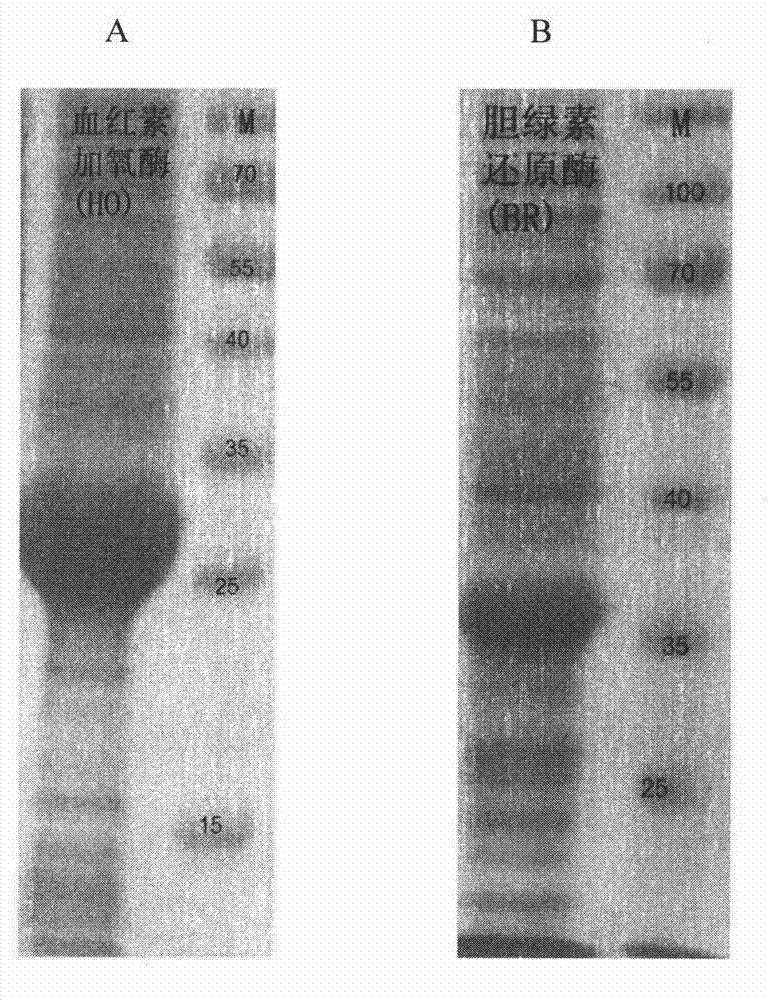Method for synthesizing bilirubin by utilizing immobilized enzyme
A technology for immobilizing enzymes and bilirubin, which is applied in the field of molecular biology and biology, and can solve the problems of high cost and high price of bilirubin
- Summary
- Abstract
- Description
- Claims
- Application Information
AI Technical Summary
Problems solved by technology
Method used
Image
Examples
Embodiment 1
[0023] Example 1: Amplification and Cloning of Heme Oxygenase Encoding Gene
[0024] Primers HO-F: 5'AACATATGTCAATAATTAATAATTATAT3' and HO-R: 5'AAGGCGCGCCCTATTTAAATCTATCAATTCT3' were set according to the gene sequence of the gene bank (GenBank NC_004557). The gene encoding heme oxygenase was amplified from Clostridium tetani E88 using the primer pair HO-F and HO-R.
[0025] Amplification conditions are: 20mM Tris-HCl (pH8.8), 10mM KCl, 10mM (NH 4 ) 2 SO 4 , 2mM MgSO 4 , 0.1% Triton X-100, 50 μM dATP, 50 μM dTTP, 50 μM dCTP, 50 μM dGTP, 400 nM primer HO-F, 400 nM primer HO-R, 1.0 U Pfu DNA polymerase (Promega, USA), pick a little with an inoculation loop Clostridium tetani E88 cells, and then adjust the reaction volume to 50 μl with sterile water.
[0026] The PCR amplification reaction program was: 95°C for 3 minutes, 35 cycles: 95°C for 50 seconds, 50°C for 30 seconds and 72°C for 1 minute, and finally 72°C for 10 minutes. The amplified product was digested with restric...
Embodiment 2
[0027] Example 2: Amplification and cloning of the gene encoding biliverdin reductase
[0028] Primers BR-F: 5'AACATATGTCTGAAAATTTTGCAGTT3' and BR R: 5'AAGGCGCGCCCTAATTTTCAACCTTATATCCA3' were designed according to the gene sequence of the gene bank (GenBank NC_000911). The gene encoding biliverdin reductase was amplified from Synechocystis sp. PCC 6803 with primer pair BR-F and BR-R.
[0029] Amplification conditions are: 20mM Tris-HCl (pH8.8), 10mM KCl, 10mM (NH 4 ) 2 SO 1 , 2mM MgSO 4 , 0.1% Triton X-100, 50 μM dATP, 50 μM dTTP, 50 μM dCTP, 50 μM dGTP, 400 nM primer BR-F, 400 nM primer BR-R, 1.0 U Pfu DNA polymerase (Promega, USA), pick a little with an inoculation loop Synechocystis sp. PCC 6803 cells, and then adjust the reaction volume to 50 μl with sterile water.
[0030] The PCR amplification reaction program was: 95°C for 3 minutes, 35 cycles: 95°C for 50 seconds, 50°C for 30 seconds and 72°C for 1 minute, and finally 72°C for 10 minutes. The amplified product wa...
Embodiment 3
[0031] Embodiment 3: the extraction of heme oxygenase
[0032] The extraction and purification of heme oxygenase mainly refer to Hong-Bo Hu, et al. Bioprocess Biosyst Eng. 2007, 30: 87-90. The specific process is as follows:
[0033] The plasmid pRSET-HO containing the heme oxygenase gene was transformed into a competent bacterial cell E. coli HB101, and cultured on a Luria broth (LB) plate (containing 100 mg / L kanamycin) at 37° C. for 24 hours. Inoculate a single clone in 5 ml LB liquid medium (containing 100 mg / L kanamycin) and culture at 30° C. for 20-24 hours. The cells were collected by centrifugation and suspended in 1 ml of 100 mM Tris-HCl buffer (pH 7.5). Bacterial cells are then lysed by sonication. Centrifuge (10°C, 17,800g, 10 minutes) and collect the supernatant, which is the crude protein extract (or crude extract).
[0034] figure 1 A shows the results of polyacrylamide gel electrophoresis of crude recombinant heme oxygenase protein, showing that heme oxygenas...
PUM
 Login to View More
Login to View More Abstract
Description
Claims
Application Information
 Login to View More
Login to View More - R&D
- Intellectual Property
- Life Sciences
- Materials
- Tech Scout
- Unparalleled Data Quality
- Higher Quality Content
- 60% Fewer Hallucinations
Browse by: Latest US Patents, China's latest patents, Technical Efficacy Thesaurus, Application Domain, Technology Topic, Popular Technical Reports.
© 2025 PatSnap. All rights reserved.Legal|Privacy policy|Modern Slavery Act Transparency Statement|Sitemap|About US| Contact US: help@patsnap.com

